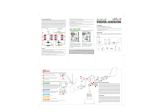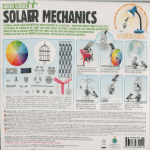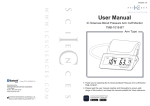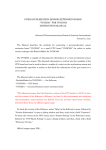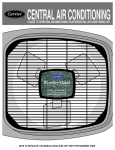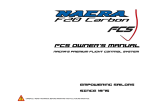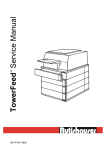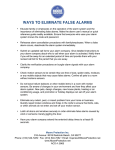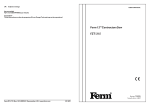Download English Instruction Manual
Transcript
F. TROUBLESHOOTING BRUSH ROBOT FUN MECHANIC SERIES If the motor does not run: • Check that you are using fresh batteries. • Check that the batteries are inserted the correct way round in the battery case. • Check that all four wires are touching the metal terminals. If the small brush becomes loose, tighten up the bolts on its bracket. You will like the other great Fun Mechanic kits: 00-03270 Tin Can Robot Millions of soda can are being wasted daily. Help recycle one of them and turn it into a cool robot which walks in silly movement when it is turned on. It could be turned to a robot monster too. Just cool. G. HOW IT WORKS The batteries provide electricity to the motor, which turns the rotor at high speed. The centre of gravity of the rotor is off to one side — it is not in line with the motor’s spindle. When the rotor spins, it makes the whole robot vibrate from side to side and up and down. The vibrations make the brushes jump off the surface and land again at high frequency. As the large brush lands after each vibration, its bristles bend, pushing the whole Robot a little the same way as the brush is angled. When the brush jumps again the bristles straighten up. This process is repeated again and again, making Brush Robot move along. To Parents: Please read through these instructions before giving gudiance to your children. A. SAFETY MESSAGES 1. Adult supervision and assistance are required at all times. 2. This kit is intended for children ages over 8. 3. This kit and its finished product contain small parts which may cause choking if misused. Keep away from children under 3 years old. 4. To prevent possible short circuits, never touch the contacts inside the battery case with any metal. B. USE OF THE BATTERY 00-03272 Smart Robot A smart robot which changes its moving path when it hits an obstacle. No remote control or programme chips. It just moves as if it has a brain. H. FUN FACTS • Brush Robot is an example of a ‘vibrobot’ — a robot that moves along because it vibrates. • A micro vibrobot is a tiny vibrobot made from a vibrating alarm from an old mobile phone and the head of a toothbrush. • Some vibrobots are solar powered, so can keep jiggling along as long as the Sun shines. • Brush vibrobots have been used to explore blocked pipes. Their bristles can go past obstructions that would stop the wheels of a normal robot. • Vibrations are used in many industrial machines. For example, vibrating conveyors move materials such as powders by making them jump up and down at high frequency. • In the construction industry, vibrating machines are used to remove air bubbles from fresh concrete and to compact loose rock and soil to make the ground firm. • Robot vacuum cleaners automatically clean floors. They learn the layout of a room, clean it, and return to their base station to recharge their batteries. • Many different materials are used to make brush bristles, including synthetic fibres, twigs, and horse and pig hairs. Synthetic fibres are made by pushing molten plastic or nylon through tiny holes. 00-03273 Bottle Catamaran Construct a cool catamaran with this unique science project. Watch your catamaran skim across the water on its pop-bottle floats, pushed by its spinning propeller. Recycle two plastic bottles to make its floats. It’s a fun mechanical kit and a recycling project too. 1. Requires two 1.5V "AAA" batteries (not included). 2. For best results, always use fresh batteries. 3. Make sure you insert the batteries with the correct polarities. 4. Remove the batteries from the kit when not in use. 5. Replace exhausted batteries straight away to avoid possible damage to the kit. 6. Rechargeable batteries must be removed from the kit before recharging. 7. Rechargeable batteries should be recharged under adult supervision. 8. Do not attempt to recharge non-rechargeable batteries. 9. Do not mix old and new batteries. 10. Do not mix alkaline, standard (carbon-zinc), or rechargeable (NiCad or NiMH) batteries. 11. Make sure that the supply terminals in the battery case are not short circuited. C. CONTENTS 1 holder for small brush 1 motor cover 2 terminal caps Questions & Comments 1 bracket for large brush 1 baseplate bolts and nuts 2 moving eyes 1 battery case with case cover 1 motor with rotor attached We value you as a customer and your satisfaction with this product is important to us. If you have comments or questions, or you find any part of this kit missing or defective, please do not hesitate to contact our distributor in your country. You will find the address printed on the package. You are also welcome to contact our Marketing Support Team: Email: [email protected], Fax (852) 25911566, Tel: (852) 28936241, Web site: WWW.4M-IND.COM 1 large brush 41-03282/1 5. Find one of the wires and a screw. Push the screw through the ring at one end of the wire. Now push the screw into one of the screw holes in the motor cover. There is a small slot next to the hole for the wire to fit through. Tighten the screw. Repeat with the other wire and another screw in the other hole in the cover. 2. Drop the motor into the housing on the baseplate, with the wire connections uppermost and closest to the battery case. Gently bend the wires over the back of the housing. 6. Gently bend the two wires upwards. Attach the two eye backs to the ends of the wires with screws through the loops in the wires. Peel off the backing from the eyes and stick them to the eye backs. 3. Now you need to connect the wires from the battery case to the wires from the motor. There are two terminal holes on the baseplate, one each side of the motor cover. Push the bare ends of the red wire from the battery case and the red wire from the motor into one hole. Push a terminal cap into the hole to trap and connect the wires. Repeat with the black wires in the other hole. 7. Turn over the baseplate and hook one side of the large brush under the bracket on the baseplate. Add the brush bracket on the opposite edge of the brush and secure it loosely with two screws. (Tighten them in step 8 see below). 10. Insert two 1.5 V "AAA" batteries into the battery case. The negative terminal (the flat end) of each battery goes against one of the springs in the battery case. If the motor runs, switch the switch to turn it off. Attach the battery case cover with a screw. Congratulations! Your Brush Robot is ready to go! E. OPERATION Put your Brush Robot on a smooth surface such as a table top or tiled or wooden floor. Switch the switch on the battery case to make the motor run, and watch Brush Robot go! 4. Push the motor cover over the motor. It should fit over the pins on the baseplate. Make sure that the motor wires fit through the two holes in the bottom of the cover without being trapped. Don’t put in the motor cover screws yet. 6 4 8 9 5 8. Slide in the large brush to the brackets. Tighten the screws of brush bracket installed in step 7. 3 2 eyebacks Also required but not included: 2 x 1.5V “AAA” batteries, small crosshead screwdriver. 1. Examine the baseplate. The upper side is the side with the motor housing on it. Push the battery case onto the pins on this side of the baseplate. The wires from the case must exit through the slot under the switch towards the motor housing. Secure the cover with two screws. 1 screws ©2008 4M Industrial Development Limited. All rights reserved. D. ASSEMBLY 2 1 small brush 7 9. Turn the baseplate the right way up again. Attach the small brush bracket to the baseplate through the hole alongside the battery case, using a nut and bolt. The bracket will only fit one way round. Screw up the bolt until the joint is tight but can still turn from side to side. Push the small brush down through the hole in the centre of the bracket, with the bristles pointing upwards. Put a nut and bolt through the holes at the end of the bracket and tighten the bolt to hold the brush in place. 10 Move the small brush up and down to make Brush Robot move backwards or forwards. The direction of movement depends on which way the large brush it tilted. You can tilt the large brush by moving the small brush up or down. The Robot’s speed depends on the angle of the tilt (more tilt means higher speed). You can make the Brush Robot steer left or right by turning the small brush bracket one way or the other. With the bracket straight (the brush in line with the centre of the large brush) the Robot should run in a straight line. If you turn the small brush over, so that the bristles are pointing down, the Robot will tend to take a more random path. Try making Brush Robot brush up dust from the floor. How about having Brush Robot races with your friends? 2 wires for eyes F. TROUBLESHOOTING BRUSH ROBOT FUN MECHANIC SERIES If the motor does not run: • Check that you are using fresh batteries. • Check that the batteries are inserted the correct way round in the battery case. • Check that all four wires are touching the metal terminals. If the small brush becomes loose, tighten up the bolts on its bracket. You will like the other great Fun Mechanic kits: 00-03270 Tin Can Robot Millions of soda can are being wasted daily. Help recycle one of them and turn it into a cool robot which walks in silly movement when it is turned on. It could be turned to a robot monster too. Just cool. G. HOW IT WORKS The batteries provide electricity to the motor, which turns the rotor at high speed. The centre of gravity of the rotor is off to one side — it is not in line with the motor’s spindle. When the rotor spins, it makes the whole robot vibrate from side to side and up and down. The vibrations make the brushes jump off the surface and land again at high frequency. As the large brush lands after each vibration, its bristles bend, pushing the whole Robot a little the same way as the brush is angled. When the brush jumps again the bristles straighten up. This process is repeated again and again, making Brush Robot move along. To Parents: Please read through these instructions before giving gudiance to your children. A. SAFETY MESSAGES 1. Adult supervision and assistance are required at all times. 2. This kit is intended for children ages over 8. 3. This kit and its finished product contain small parts which may cause choking if misused. Keep away from children under 3 years old. 4. To prevent possible short circuits, never touch the contacts inside the battery case with any metal. B. USE OF THE BATTERY 00-03272 Smart Robot A smart robot which changes its moving path when it hits an obstacle. No remote control or programme chips. It just moves as if it has a brain. H. FUN FACTS • Brush Robot is an example of a ‘vibrobot’ — a robot that moves along because it vibrates. • A micro vibrobot is a tiny vibrobot made from a vibrating alarm from an old mobile phone and the head of a toothbrush. • Some vibrobots are solar powered, so can keep jiggling along as long as the Sun shines. • Brush vibrobots have been used to explore blocked pipes. Their bristles can go past obstructions that would stop the wheels of a normal robot. • Vibrations are used in many industrial machines. For example, vibrating conveyors move materials such as powders by making them jump up and down at high frequency. • In the construction industry, vibrating machines are used to remove air bubbles from fresh concrete and to compact loose rock and soil to make the ground firm. • Robot vacuum cleaners automatically clean floors. They learn the layout of a room, clean it, and return to their base station to recharge their batteries. • Many different materials are used to make brush bristles, including synthetic fibres, twigs, and horse and pig hairs. Synthetic fibres are made by pushing molten plastic or nylon through tiny holes. 00-03273 Bottle Catamaran Construct a cool catamaran with this unique science project. Watch your catamaran skim across the water on its pop-bottle floats, pushed by its spinning propeller. Recycle two plastic bottles to make its floats. It’s a fun mechanical kit and a recycling project too. 1. Requires two 1.5V "AAA" batteries (not included). 2. For best results, always use fresh batteries. 3. Make sure you insert the batteries with the correct polarities. 4. Remove the batteries from the kit when not in use. 5. Replace exhausted batteries straight away to avoid possible damage to the kit. 6. Rechargeable batteries must be removed from the kit before recharging. 7. Rechargeable batteries should be recharged under adult supervision. 8. Do not attempt to recharge non-rechargeable batteries. 9. Do not mix old and new batteries. 10. Do not mix alkaline, standard (carbon-zinc), or rechargeable (NiCad or NiMH) batteries. 11. Make sure that the supply terminals in the battery case are not short circuited. C. CONTENTS 1 holder for small brush 1 motor cover 2 terminal caps Questions & Comments 1 bracket for large brush 1 baseplate bolts and nuts 2 moving eyes 1 battery case with case cover 1 motor with rotor attached We value you as a customer and your satisfaction with this product is important to us. If you have comments or questions, or you find any part of this kit missing or defective, please do not hesitate to contact our distributor in your country. You will find the address printed on the package. You are also welcome to contact our Marketing Support Team: Email: [email protected], Fax (852) 25911566, Tel: (852) 28936241, Web site: WWW.4M-IND.COM 1 large brush 41-03282/1 5. Find one of the wires and a screw. Push the screw through the ring at one end of the wire. Now push the screw into one of the screw holes in the motor cover. There is a small slot next to the hole for the wire to fit through. Tighten the screw. Repeat with the other wire and another screw in the other hole in the cover. 2. Drop the motor into the housing on the baseplate, with the wire connections uppermost and closest to the battery case. Gently bend the wires over the back of the housing. 6. Gently bend the two wires upwards. Attach the two eye backs to the ends of the wires with screws through the loops in the wires. Peel off the backing from the eyes and stick them to the eye backs. 3. Now you need to connect the wires from the battery case to the wires from the motor. There are two terminal holes on the baseplate, one each side of the motor cover. Push the bare ends of the red wire from the battery case and the red wire from the motor into one hole. Push a terminal cap into the hole to trap and connect the wires. Repeat with the black wires in the other hole. 7. Turn over the baseplate and hook one side of the large brush under the bracket on the baseplate. Add the brush bracket on the opposite edge of the brush and secure it loosely with two screws. (Tighten them in step 8 see below). 10. Insert two 1.5 V "AAA" batteries into the battery case. The negative terminal (the flat end) of each battery goes against one of the springs in the battery case. If the motor runs, switch the switch to turn it off. Attach the battery case cover with a screw. Congratulations! Your Brush Robot is ready to go! E. OPERATION Put your Brush Robot on a smooth surface such as a table top or tiled or wooden floor. Switch the switch on the battery case to make the motor run, and watch Brush Robot go! 4. Push the motor cover over the motor. It should fit over the pins on the baseplate. Make sure that the motor wires fit through the two holes in the bottom of the cover without being trapped. Don’t put in the motor cover screws yet. 6 4 8 9 5 8. Slide in the large brush to the brackets. Tighten the screws of brush bracket installed in step 7. 3 2 eyebacks Also required but not included: 2 x 1.5V “AAA” batteries, small crosshead screwdriver. 1. Examine the baseplate. The upper side is the side with the motor housing on it. Push the battery case onto the pins on this side of the baseplate. The wires from the case must exit through the slot under the switch towards the motor housing. Secure the cover with two screws. 1 screws ©2008 4M Industrial Development Limited. All rights reserved. D. ASSEMBLY 2 1 small brush 7 9. Turn the baseplate the right way up again. Attach the small brush bracket to the baseplate through the hole alongside the battery case, using a nut and bolt. The bracket will only fit one way round. Screw up the bolt until the joint is tight but can still turn from side to side. Push the small brush down through the hole in the centre of the bracket, with the bristles pointing upwards. Put a nut and bolt through the holes at the end of the bracket and tighten the bolt to hold the brush in place. 10 Move the small brush up and down to make Brush Robot move backwards or forwards. The direction of movement depends on which way the large brush it tilted. You can tilt the large brush by moving the small brush up or down. The Robot’s speed depends on the angle of the tilt (more tilt means higher speed). You can make the Brush Robot steer left or right by turning the small brush bracket one way or the other. With the bracket straight (the brush in line with the centre of the large brush) the Robot should run in a straight line. If you turn the small brush over, so that the bristles are pointing down, the Robot will tend to take a more random path. Try making Brush Robot brush up dust from the floor. How about having Brush Robot races with your friends? 2 wires for eyes


